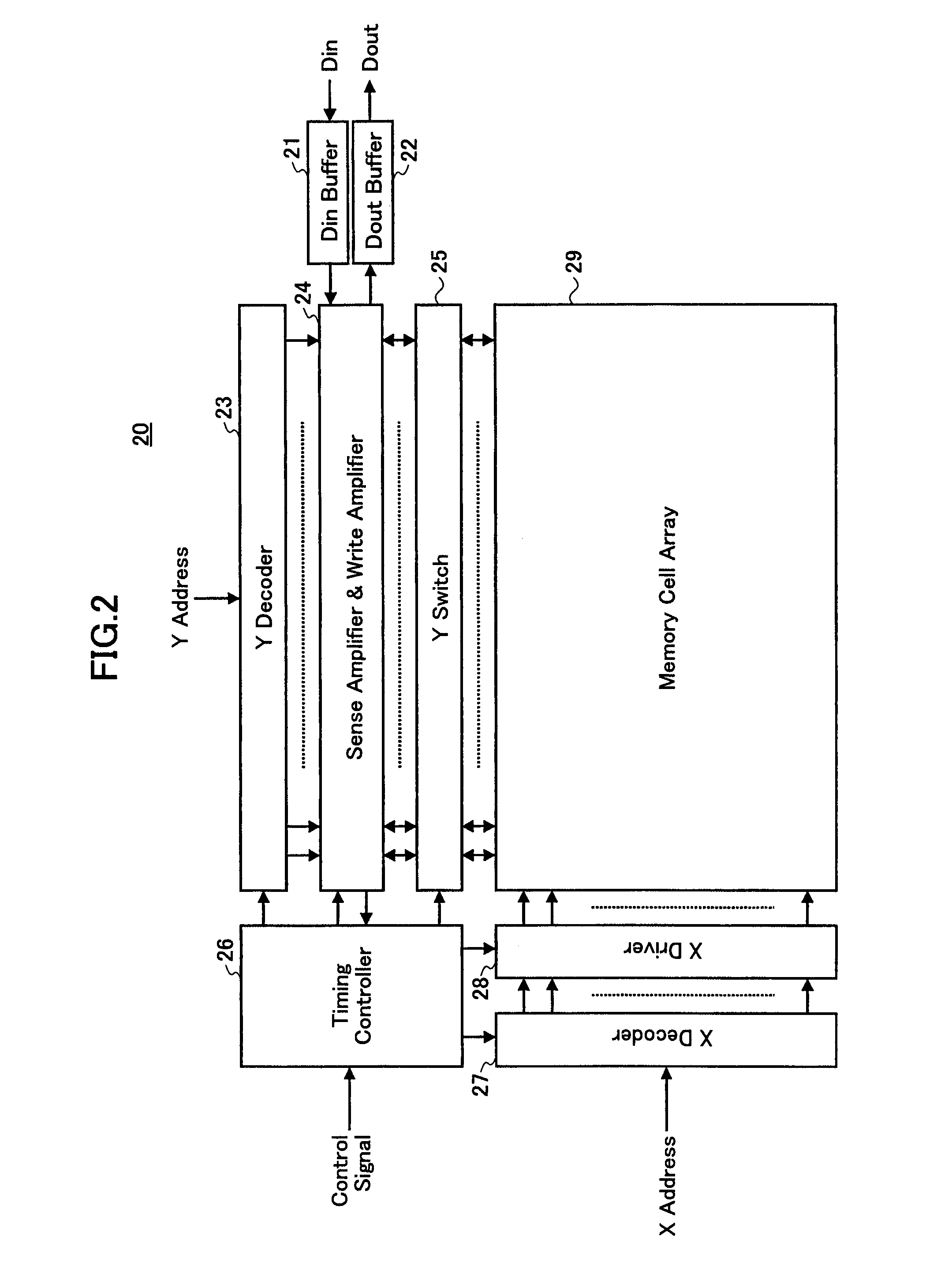Nonvolatile memory utilizing hot-carrier effect with data reversal function
a non-volatile memory and data reversal technology, applied in the field of memory circuits, can solve problems such as increasing manufacturing costs, and achieve the effect of enhancing data-write speed
- Summary
- Abstract
- Description
- Claims
- Application Information
AI Technical Summary
Benefits of technology
Problems solved by technology
Method used
Image
Examples
first embodiment
[0065]FIG. 2 is a block diagram showing the configuration of a nonvolatile semiconductor memory device according to the present invention. A semiconductor memory device 20 shown in FIG. 2 includes a Din buffer 21, a Dout buffer 22, a Y decoder 23, a write-amplifier-&-sense-amplifier unit 24, a Y switch 25, a timing controller 26, an X decoder 27, an X driver 28, and a memory cell array 29.
[0066]The memory cell array 29 includes a plurality of memory cells arranged in a matrix form, with a plurality of word lines extending in a first direction, and a plurality of bit lines extending in a second direction perpendicular to the first direction. Each memory cell has a circuit configuration as will later be described. The memory cells arranged in the same column (same Y address) are connected to the same bit lines, and the memory cells arranged in the same row (same X address) are connected to the same word line.
[0067]The timing controller 26 receives control signals from an exterior of t...
second embodiment
[0099]FIGS. 7A and 7B are illustrative drawings for explaining the write and store operations of the memory cell shown in FIG. 3. In FIGS. 7A and 7B, the same elements as those of FIGS. 2, 3, and 4A through 4C are referred to by the same numerals, and a description thereof will be omitted.
[0100]FIG. 7A shows a write operation by which data supplied from the exterior of the semiconductor memory device 20 is stored in the SRAM cell 50. As shown in FIG. 7A, the SRAM word line SWL is set to HIGH, and the NV word line CWL is set to LOW. Further, the recall plate voltage enable line RPLE is set to LOW, and the store plate voltage enable line WPLEB is set to HIGH.
[0101]With these settings of the signal lines, data is supplied from the exterior to the write buffer 60 via the Din buffer 21. The two binary values output from the write buffer 60 to the bit lines BLN and BLT are stored in the SRAM cell 50, with the SRAM word line SWL being in the HIGH state to couple the bit lines BLN and BLT t...
third embodiment
[0142]FIG. 17 is a block diagram showing the configuration of a nonvolatile semiconductor memory device according to the present invention. In FIG. 17, the same elements as those of FIG. 10 are referred to by the same numerals, and a description thereof will be omitted.
[0143]A semiconductor memory device 20B shown in FIG. 17 differs from the semiconductor memory device 20A shown in FIG. 10 in that the input into an inverting circuit (71B) shown in FIG. 17 is supplied directly from the sense amplifier unit 24-2, and that the output from the inverting circuit is supplied to the ECC check-&-correct unit 72. Such provision is made in this embodiment in order to perform the inversion of data bits and redundant bits as post-processing after a recall operation.
[0144]FIG. 18 is an illustrative drawing for explaining a store operation of the semiconductor memory device 20B. In FIG. 18, the same elements as those of FIG. 17 are referred to by the same numerals, and a description thereof will ...
PUM
 Login to View More
Login to View More Abstract
Description
Claims
Application Information
 Login to View More
Login to View More - R&D
- Intellectual Property
- Life Sciences
- Materials
- Tech Scout
- Unparalleled Data Quality
- Higher Quality Content
- 60% Fewer Hallucinations
Browse by: Latest US Patents, China's latest patents, Technical Efficacy Thesaurus, Application Domain, Technology Topic, Popular Technical Reports.
© 2025 PatSnap. All rights reserved.Legal|Privacy policy|Modern Slavery Act Transparency Statement|Sitemap|About US| Contact US: help@patsnap.com



